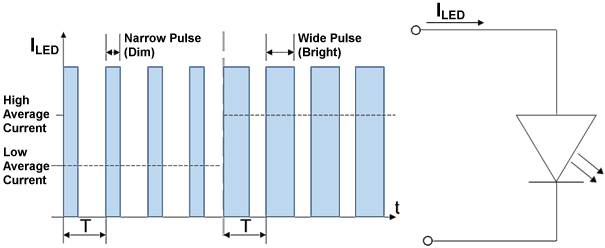Operation modes
There are two operation modes for LEDs: continuous operation and pulse operation. Each operation mode has advantages and disadvantages, therefore a decision has to be made about which mode to use depending on the use case.
1. Continuous operation
An LED circuit can be designed for continuous operation. The LED is then switched on continuously. In this operation mode the current through the LED may not exceed the nominal current.
- Advantages: Simpler and cheaper circuit
- Disadvantages: Only a small part of the maximum possible luminous flux of the LED can be used. Continuous operation generates higher waste heat, leading to faster aging of the LED.
Continuous operation can take place in various ways:
a. Current and voltage output
The continuous switching on of a voltage or current (depending on the selected control method) leads to a continuous light. The description, as well as the advantages and disadvantages of the two control methods can be found in the chapter Control.
b. Pulse width modulation (PWM)
If the constant current or constant voltage with series resistor is clocked quickly in the kHz range, this is referred to as a PWM mode. The true-color brightness can then be adjusted by adapting the duty factor of the pulse width modulation (PWM). By switching the power supply on and off with a sufficiently high frequency and a preset duty cycle (0...100%), the flashing appears to the human eye like a continuous light. By changing the duty cycle, the current averaged over time is reduced or increased by the LED, thus adjusting the brightness.
 Fig.15: Control of an LED with PWM
Fig.15: Control of an LED with PWM- Advantages: true-color brightness adjustment
- Disadvantages: supply must be able to provide rapidly increasing currents, complex supply source may be required
2. Pulse operation
In some applications an “overdrive” may be desired, as the light power in continuous operation with the nominal current is insufficient. The LED is operated briefly for a few µs to ms with a considerably higher power than in nominal operation by means of a brief and pulsating increase in the current above the nominal current. This results in briefly higher luminous fluxes. The LED can cool down again in the subsequent pause.
Overdriving leads to increased development of heat in the LEDs. The temperature of the LED chip must not increase beyond the temperature limit value during the pulse. The LED will otherwise be damaged. Following a pulse, there must be a sufficiently long pause (switch-off time) before the next pulse so that the LED can cool down. The ratio of switch-on to switch-off time is set by the duty cycle. A maximum duty cycle of 10% is often set for pulse operation. Hence, the pulse duration may not exceed 10% of the entire period. The precise values are to be taken from the manufacturer's data sheets.

 Fig.16: Temperature and brightness as a function of time in pulse operation
Fig.16: Temperature and brightness as a function of time in pulse operation- Advantages: The maximum luminous flux of the LED can be utilized. If the duty cycle is adhered to or undershot, the waste heat created is at the most as much as in continuous operation. If the maximum duty cycle is undershot so that the average power is less than in continuous operation, this can lead to less aging and thus to a longer service life.
- Disadvantages: Requires a more elaborate circuit and control solution, for example in the form of a flash controller
Here, too, implementation via a voltage or current output is possible. The output values must then be dimensioned in such a way that the output flash reaches the desired brightness. The maximum output power must always be taken into account when dimensioning the flashes.
The output of light pulses is also possible with fast PWM. A light flash with a length of 1 ms is generated with 1 kHz PWM.